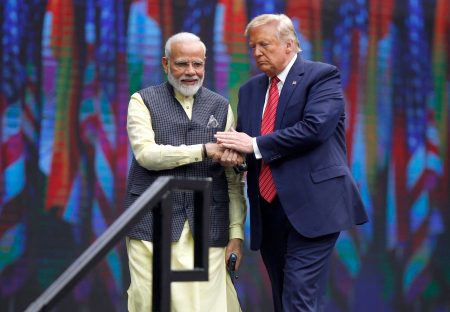Reading Time: 6 minutes
America, the land of promise, is a major destination. As Trump’s visit is underway, Navodita unravels the many layers of popular culture. An exclusive for Different Truths.
 As Trump’s visit is underway in India, it is worth thinking about what makes America so desirable by all across the world. The land of milk and honey is a major destination on everyone’s mind when planning a holiday, or even studying abroad. Possibly culture is the buzzword here. America — the land of dreams, America — the land of freedom, America — the land of possibilities. All this is served through ‘popular culture’. Much as India’s carrier of ‘popular culture’ is Bollywood.
As Trump’s visit is underway in India, it is worth thinking about what makes America so desirable by all across the world. The land of milk and honey is a major destination on everyone’s mind when planning a holiday, or even studying abroad. Possibly culture is the buzzword here. America — the land of dreams, America — the land of freedom, America — the land of possibilities. All this is served through ‘popular culture’. Much as India’s carrier of ‘popular culture’ is Bollywood.
What is Popular Culture
This word is a divergent ‘member’ of the culture family: contradictory and often inconsistent. It is a term that is hard to explain and a subject that is hard to teach. Carla Freccero described ‘popular culture as a domain of degraded culture. Yet this, explains Freccero, provided her with the ideal opportunity to argue the case for the importance of popular culture. It was the “contradictoriness”, the “potential progressive productivity”, the liberalism, and the hidden complexity that finally is assimilative in the subject.
The popular culture is one of those cases, where ‘subjective experience’ variable plays a big role in the investigation of the phenomenon. In some extreme cases, it may hold true that the explanation behind the nature of popular culture depends solely on a subjective perception of a person (or group of persons) at a particular time and place.
Much of what follows is a summary of the different ways in which popular culture has been defined and analysed. Unfortunately, it is impossible to understand the all — encompassing nature of popular culture. Instead, the focus is on formulating the best explanations possible by drawing from three different theoretical perspective- previous conceptual and empirical research, non-academic information resources, and the researcher’s subjective interpretations. The popular culture is one of those cases, where ‘subjective experience’ variable plays a big role in the investigation of the phenomenon. In some extreme cases, it may hold true that the explanation behind the nature of popular culture depends solely on a subjective perception of a person (or group of persons) at a particular time and place. This may seem counter-intuitive, as the ‘popular’ in popular culture implies a unified comprehensible set of ideas universally accepted by many people. In approaching popular culture, its polycultural nature should lack complexity- must be altogether apparent and comprehensible, be amenable to easy interpretation and analysis. Unfortunately, it is not the case.
As Bennett (1980) points out, “the concept of popular culture is virtually useless, a melting pot of confused and contradictory meanings capable of misdirecting inquiry up any number of theoretical blind alleys”. Defining popular culture is an ambitious agenda, and a certain hesitation in laying out the ideas is only natural. From linguistic perspective, there may be two approaches to explaining the term popular culture. One, synchronic approach, considers the term at this particular moment in time – the present – without taking its history into account. The other, a diachronic approach, considers the development and evolution of the term through history. Given the complexity of the task, we begin with the historical background; followed by synchronic semantics, cultural role and public perception.
One of the distinctive features of popular culture is the dynamic diversity. The dynamism is driven by the advancement of new technology, while its diversity lies within the deeper nature of the phenomenon. It is quite challenging to explain popular culture without fragmenting it
One of the distinctive features of popular culture is the dynamic diversity. The dynamism is driven by the advancement of new technology, while its diversity lies within the deeper nature of the phenomenon. It is quite challenging to explain popular culture without fragmenting it, and most attempts to subsume it under one category proved futile. It is in fact a very broad conceptual category. Many people intuitively understand what popular culture means, yet there is no one widely accepted definition. The multifaceted nature of popular culture raises more questions than it answers. Therefore, the aim of this section is to map out the general conceptual landscape of popular culture. As Storey (2009) reflects, “to study popular culture we must first confront the difficulty posed by the term itself”.
Before making any attempts to define popular culture, it seems necessary to first

examine the term ‘culture’. One of the earliest definitions of culture, and one still used today, was offered by British anthropologist Sir Edward Burnett Tylor. Sir Edward Tylor (1871) offered a broad definition, stating that culture in its wide ethnographic sense is “that complex whole which includes knowledge, belief, art, morals, law, custom, and any other capabilities and habits acquired by man as a member of society”. In the 20th century American anthropologist Ruth Benedict offered a more succinct definition by characterising culture as a set of ideas and standards that people have in common. Years went by and the term culture evolved into something bigger than a set of standards, customs and beliefs. It added symbolism to its pool of meaning. An explanation provided by Geertz (1973) described culture as “a system of inherited conceptions expressed in symbolic forms by means of which men communicate, perpetuate, and develop their knowledge about and attitudes toward life”. This explanation takes us a step closer to the modern interpretation of the term. According to Samovar, Porter, and McDaniel (1999), the contemporary definitions of culture commonly mention shared values, attitudes, beliefs, behaviours, norms, material objects, and symbolic resources. In their work they propose a simplified explanation of culture, stating that culture is the “rules for living and functioning in society”.
From cultural traditions of “a particular community”, popular culture transformed into the “general culture of a society”. These examples illustrate how in the course of time popular culture can broaden its influence and stretch beyond the extent of a ‘particular’ community.
The culture is too dynamic to be contained within the borders of a single explanation. From cultural traditions of “a particular community”, popular culture transformed into the “general culture of a society”. These examples illustrate how in the course of time popular culture can broaden its influence and stretch beyond the extent of a ‘particular’ community. This gradual yet constant transformation persists probably owing to the fact that social borders become more blurred the further we enter into the 21st century, and technologies provide easier access to the many cultural resources.
The changes in the definition of popular culture take place not only due to the social evolution of cultures and societies over periods of time. The differences in the interpretation of popular culture occur in coexisting contemporary sources as well. For example, the online Urban Dictionary Urbandictionary.com defines popular culture as “a widely accepted group of practices or customs”. While as the online dictionary Oxforddictionaries.com, developed by the University of Oxford, defines popular culture as a modern culture transmitted via mass media and aimed particularly at younger people. It is interesting to note that both contemporary definitions do not differentiate between social classes.
Adorno (1991) uses Marx’s theory of commodity fetishism to understand popular culture. For Adorno and the Frankfurt School, commodity fetishism is the basis of the theory on how different cultural forms can secure the domination of capitalism (Strinati, 2004). Naturally, this line of thinking inspired disagreement.
Some studies suggest, in capitalist societies popular culture is viewed as part of the ‘commodity fetishism’. For example, Adorno (1991) uses Marx’s theory of commodity fetishism to understand popular culture. For Adorno and the Frankfurt School, commodity fetishism is the basis of the theory on how different cultural forms can secure the domination of capitalism (Strinati, 2004). Naturally, this line of thinking inspired disagreement. In his work Fiske (1989) offers a contrasting perspective. He states: “Popular culture is not consumption, it is culture – the active process of generating and circulating meanings and pleasures within a social system”. He further elaborates by saying that “All the culture industries can do is produce a repertoire of texts or cultural resources for the various formations of the people to use or reject in the ongoing process of producing their popular culture”. This means that popular culture is far more complex than a mass consumption of a cultural resource. It is an elaborate process of selection and rejection of cultural practices.
What many academic works on popular culture have in common is the fact that it is mostly defined, implicitly or explicitly, in contrast to or as a product of other conceptual categories, such as folk culture, mass culture, high culture, dominant culture, low culture. How then culture gets defined by technology and other things is also under discussion. For some, culture changes with the medium. Recently culture has undergone many changes since the advent of Internet and technology, not just in India but across the world.
Photo from the Internet














